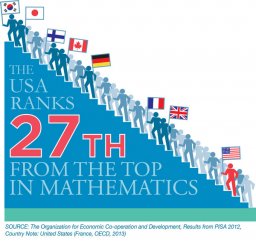BY Miha Vindis, LBJ School Ph.D. student
The world has changed in many ways since the Cold War ended. The internet and mobile communication have opened up new possibilities across the world. As high-tech, high-value generating industries are no longer bound by national borders or access to restricted resources, a new world order has began to emerge. In this new world education has become even more important. The US – and the West as a whole – has seen its advantage in economic, technological and defense arenas erode, because we are beginning to fall behind the rest of the world. While the political establishment debates, increasingly on ideological grounds, the future of America is at risk.
The problem begins very early in the national academic system. Beginning in elementary school many students are already behind the nationally accepted standards. For example, one study found that only 31 percent of fourth graders are proficient in reading on the NAEP (National Assessment of Educational Progress) and by eighth grade this number is virtually the same (33 percent). If the average student is not an efficient reader, how can we expect them to excel? One can find similarly alarming statistics for math and the problems compound by the time students are in high-school. In fact, according the Heritage Foundation about one in three American students fail to graduate from highschool. What is most worrying is that the numbers are getting worse in relative and absolute terms. In 2008, the US was the only developed country with a higher percent of 55- to 64-year-olds with high school degrees than 25- to 34-year-olds.
The data for college level education is also not positive. Just over 40 percent of American’s earn a college a degree – a number which has not changed in decades – while other nations have been catching up. Consider this fact: when the baby boomer generation was completing college in the 70s, more than 30 percent of all college graduates in the world were Americans, but today, that number is only 20 percent. While part of this can be explained by rapid population growth rates in some countries (for example, China’s proportion of college graduates tripled in the last two decades) data clearly shows that the US is beginning to lag in higher education. According to the OECD (Organization for Economic Co-operation and Development) significant progress has been made in China, Korea, Mexico and Brazil… countries often seen as up and coming geopolitical competitors.
The problem is not necessarily one of quality in higher education. Many foreigners (this author included) still choose to come to the US because the value offered by American universities is very high, despite very high costs (international students have limited options in terms of funding or student employment). As a Slovenian living in the US, I constantly contrast America with Europe. And while I am willing to pay the extra cost for an American higher education, I see no such incentive for primary or secondary education. Simply put, American college education may be the most expensive in the world, but it also offers some of the best employment and earnings opportunities. The problem, therefore, is not quality or potential, but rather the small number of Americans earning degrees in critical areas and the even smaller number who are prepared for rigorous study in those fields.
The most serious problem is in the area of STEM (Science, Technology, Engineering, and Math), where there are almost 3 million unfilled jobs, but only about 300, 000 graduates annually. This shortage of US-born STEM workers gives companies two choices: import costly foreign labor, or move operations abroad. In fact, according to the OECD the US has less PhD STEM graduates (per million population) than many other developed countries. The picture is even bleaker when one considers that many of those advanced degrees are awarded to foreigners. For example, about half of all engineering doctoral degrees are awarded to non-US nationals. The implications of this shortfall are not only economic, but also a national security concern as it will become increasingly difficult to fill sensitive security-related jobs.
Most policy-makers would not dispute these facts: education in the US is falling behind. Identifying the problem and recommending a solution, however, is becoming increasingly ideological. Politicians on both sides of the aisle are all too eager to turn critical issues into an ideological battle rathen seek a realistic compromise. The US desperately needs an overhaul of the education system, but given today’s political reality it is not clear when that will happen.
It would be foolish to pinpoint any one issue as the sole problem with education. The education system doesn’t need tweaks and fixes, it needs a serious overhaul. The system needs to be adjusted to attract qualified, motivated teachers through fair compensation; national and state curriculums need to be updated to reflect the realities of the post-Cold War era; school testing norms need to be redesigned; and effective means of motivating students have to be implemented. What is at stake is far more than just increasing reading or math test scores; without a well educated population the American advantage in just about every field will continue to erode. The world may be in the hands of the current power elite, but the future is in the hands of the next generation. No country serious about its future can afford to forget that and no patriotic policy maker should ignore that.








